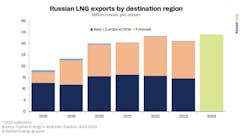Sam Fletcher
OGJ Senior Writer
HOUSTON, May 26 -- Energy prices continued climbing for a second consecutive day May 25 on the New York market, with the front-month contract for benchmark crude finally penetrating market resistance above $100/bbl after failing to do so for 9 sessions.
“If $100/bbl West Texas Intermediate can hold as a support, then the momentum target will be the recent closing high at $103.88/bbl and then the 50-day moving average at $105.50/bbl,” said Olivier Jakob at Petromatrix, Zug, Switzerland. “The 100-day moving average has been defended as a line of support, and that line is gradually moving to $100/bbl [from $99/bbl currently].” Support for higher crude prices came from North Sea Brent “more than from WTI,” he said.
In Houston, analysts at Raymond James & Associates Inc. reported, “A 10% weekly increase in distillate demand and an unexpected decline in distillate inventories drove crude prices up 2%.... Boosted by the rise in crude, the oil service index and the SIG Oil Exploration & Production Index (EPX) jumped more than 2% to outperform the broader market, which posted modest gains in a light day of trading.”
Natural gas rose almost 1% ahead of the latest government report on US storage. The price of crude declined while the price of natural gas remained relatively flat in early trading May 26.
Also, the euro recovered some its recently lost value, which boosted oil prices.
James Zhang at Standard New York Securities Inc., the Standard Bank Group, reported, “Heating oil was the leader in the oil complex after a sizable draw in US distillate inventories.” Meanwhile, the reformulated blend stock (RBOB) crack continued to weaken as total US gasoline inventories advanced above the 5-year average.
“The term structure for WTI weakened slightly and remained firmly in contango at the front-end of the curve, due to persistently high inventories at Cushing, Okla.,” Zhang said.
Crude prices have remained range-bound since “the abrupt downward correction” on May 5 “when WTI and Brent each lost around 9%,” Zhang reported. “This correction has pushed benchmark oil prices back to levels seen just after the Libya civil war broke out in February. It has effectively negated the Middle East, North Africa [MENA] geopolitical risk premium in crude prices because the contagion risk to other major oil-producing countries in this region has diminished.”
In the interim, he said, “Global crude oil inventories have been drawn down much faster because of the supply shortfall from Libya. In addition, the decline in oil product inventories is more pronounced than those of crude due to losses in refining capacity in Japan.”
Zhang said, “In the medium term, we see further tightening in the oil market because it will take a long time for Libya’s supply to recover fully. Furthermore, military attacks on Libya’s oil fields and infrastructure might have caused considerable damage, which will take a long time to repair. In addition, oil demand is picking up, albeit at a slower pace, as the global economy grows.”
In other news, Zhang said, “The Icelandic [volcanic] ash cloud that has seen the cancellation of about 1,000 flights in Europe appears to be ending. As a result, the European jet differential over gas oil is likely to recover, barring further air traffic disruptions. After all, jet inventories [at the Amsterdam, Rotterdam, and Antwerp (ARA) markets] stand some 30% below the seasonal level of the previous 2 years, while the ARA gas oil inventory is at multi-year highs. More importantly, the market is heading into the peak demand season for jet, but the opposite for gas oil during the summer.”
Meanwhile, orders for US durable goods dropped more than expected in April, reflecting less demand for aircraft and disruptions in supplies of auto parts stemming from the earthquake in Japan.
“The weakness in the auto sector echoes the US April industrial production data released last week, which showed that the auto sector had fallen by 8.9% month-to-month,” Zhang reported. “We expect a relatively quick recovery as the underlying demand for motor vehicles is still solid in the US.”
US inventories
The Energy Information Administration reported May 26 the injection of 105 bcf of natural gas into US underground storage in the week ended May 20, exceeding the Wall Street consensus of 94 bcf. That raised working gas in storage to more than 2.02 tcf. That is 230 bcf less than last year at this time and 26 bcf below the 5-year average.
EIA earlier reported commercial US inventories of crude increased 600,000 bbl to 370.9 million bbl in that same week.
The Wall Street consensus was for a decline of 1 million bbl. Gasoline stocks escalated by 3.8 million bbl to 209.7 million bbl, counter to expectations of a 1.5 million bbl drop. Both finished gasoline and blending components were up.
Distillate fuel inventories fell 2 million bbl to 141.1 million bbl despite market anticipation of a 500,000 bbl gain (OGJ Online, May 25, 2011).
Energy prices
The July contract for benchmark US light, sweet crudes climbed by $1.73 to $101.32/bbl May 25 on the New York Mercantile Exchange. The August contract gained $1.76 to $101.82/bbl. On the US spot market, WTI at Cushing jumped by $2.23 to match the July futures contract closing price of $101.32/bbl.
Heating oil for June delivery advanced 7.06¢ to $2.98/gal on NYMEX. RBOB for the same month increased 2.34¢ to $3.02/gal.
The June natural gas contract was up 3.4¢ to $4.38/MMbtu on NYMEX. On the US spot market, however, gas at Henry Hub, La., dipped 0.7¢ to $4.36/MMbtu.
In London, the July IPE contract for North Sea Brent crude gained $2.40 to $114.93/bbl. Gas oil for June escalated by $17.75 to $937/tonne.
The average price for the Organization of Petroleum Exporting Countries' basket of 12 reference crudes increased 69¢ to $107.99/bbl.
Contact Sam Fletcher at [email protected]

